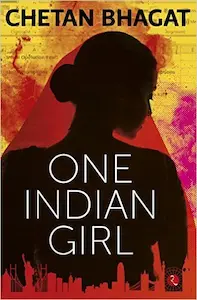One Indian Girl - Summary
Chetan Bhagat

Introduction
In this book summary, we will explore “One Indian Girl” by Chetan Bhagat, a renowned Indian author known for his captivating storytelling. Published in 2016, this novel delves into the life of a modern Indian woman named Radhika Mehta, who challenges societal norms and navigates through love, career, and self-discovery. Through this summary, we will analyze the key themes, characters, and narrative techniques employed by Bhagat to create an engaging and thought-provoking story.
Radhika Mehta: A Strong and Independent Protagonist
The novel revolves around Radhika Mehta, a successful investment banker working in New York City. Radhika is a strong and independent woman who defies traditional gender roles. Bhagat portrays her as a relatable character, providing readers with a glimpse into the challenges faced by modern Indian women in both personal and professional spheres.
The Struggle for Independence and Identity
One of the central themes in “One Indian Girl” is the struggle for independence and identity. Radhika, being an ambitious woman, faces societal pressure to conform to traditional expectations. She battles against the stereotypes imposed on her by her family, society, and even her romantic partners. Bhagat uses Radhika’s story to shed light on the importance of individuality and the pursuit of personal dreams.
Love, Relationships, and Feminism
Bhagat weaves a complex web of love and relationships throughout the narrative. Radhika finds herself torn between three men who each represent different aspects of her life. The author skillfully explores the dynamics of these relationships, highlighting the challenges faced by modern women in balancing career aspirations and personal desires. Through Radhika’s journey, Bhagat raises important questions about feminism and the societal expectations placed on women.
Anecdote: The Goa Wedding
One memorable anecdote from the book is the Goa wedding. Radhika attends a lavish wedding where she witnesses the stark contrast between the traditional expectations of Indian society and the desire for personal freedom. The wedding serves as a turning point for Radhika, prompting her to question her own choices and the sacrifices she has made for the sake of societal acceptance.
The Glass Ceiling and Workplace Discrimination
Bhagat also delves into the issue of workplace discrimination and the glass ceiling faced by women in male-dominated industries. Radhika’s experiences in the corporate world shed light on the challenges women encounter in climbing the career ladder. Through her character, Bhagat highlights the need for gender equality and the importance of breaking down barriers that hinder women’s progress.
Anecdote: The New York Boardroom
In a powerful scene set in a New York boardroom, Radhika confronts the gender bias and discrimination prevalent in the corporate world. Bhagat skillfully portrays the frustration and determination of his protagonist as she fights for recognition and equal treatment. This anecdote serves as a catalyst for Radhika’s personal and professional growth, inspiring readers to challenge societal norms and strive for change.
The Influence of Indian Culture
Bhagat masterfully incorporates elements of Indian culture and traditions into the narrative. He explores the clash between modernity and tradition, highlighting the struggles faced by individuals attempting to navigate both worlds. Radhika’s experiences with arranged marriages, family expectations, and societal judgment provide readers with a deeper understanding of the complexities of Indian culture.
Anecdote: The Family Pressure
One poignant anecdote from the book is Radhika’s encounter with family pressure. Her parents insist on arranging her marriage, disregarding her desires and aspirations. This anecdote resonates with many readers who have experienced similar pressures, shedding light on the importance of individual choice and the need to challenge societal norms.
Narrative Style and Engaging Storytelling
Bhagat’s narrative style is engaging and accessible, making “One Indian Girl” a page-turner. The author skillfully combines humor, romance, and social commentary, creating a compelling story that captivates readers from start to finish. Bhagat’s ability to tackle serious issues with a light-hearted tone makes the novel both informative and entertaining.
Conclusion
“One Indian Girl” by Chetan Bhagat is a thought-provoking novel that explores the struggles faced by modern Indian women in their pursuit of independence, love, and self-discovery. Through the character of Radhika Mehta, Bhagat challenges societal norms, raises questions about feminism, and highlights the importance of individual choice. With its engaging storytelling and relatable characters, this book offers readers an insightful glimpse into the complexities of contemporary Indian society.